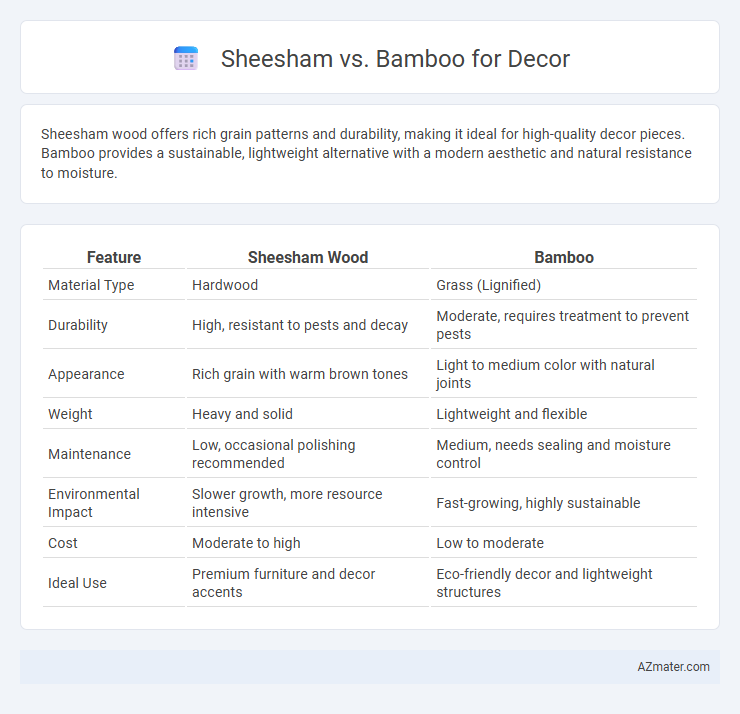Sheesham wood offers rich grain patterns and durability, making it ideal for high-quality decor pieces. Bamboo provides a sustainable, lightweight alternative with a modern aesthetic and natural resistance to moisture.
Table of Comparison
| Feature | Sheesham Wood | Bamboo |
|---|---|---|
| Material Type | Hardwood | Grass (Lignified) |
| Durability | High, resistant to pests and decay | Moderate, requires treatment to prevent pests |
| Appearance | Rich grain with warm brown tones | Light to medium color with natural joints |
| Weight | Heavy and solid | Lightweight and flexible |
| Maintenance | Low, occasional polishing recommended | Medium, needs sealing and moisture control |
| Environmental Impact | Slower growth, more resource intensive | Fast-growing, highly sustainable |
| Cost | Moderate to high | Low to moderate |
| Ideal Use | Premium furniture and decor accents | Eco-friendly decor and lightweight structures |
Introduction to Sheesham and Bamboo in Decor
Sheesham wood, known for its rich grains and durability, offers a luxurious and timeless appeal in decor, making it a preferred choice for high-end furniture and intricate carvings. Bamboo stands out with its sustainability and lightweight nature, providing a modern, eco-friendly aesthetic ideal for minimalist and versatile decor designs. Both materials serve distinctive decor purposes, with Sheesham delivering classic elegance and Bamboo promoting environmentally conscious style.
Material Origins and Sustainability
Sheesham, also known as Indian rosewood, originates from the Indian subcontinent and is valued for its dense grain and rich, warm tones, making it a premium choice for durable and visually striking decor. Bamboo, a fast-growing grass native to Asia and other tropical regions, offers exceptional sustainability due to its rapid renewability and carbon sequestration capabilities. While Sheesham provides longevity and natural resistance to pests and decay, bamboo's eco-friendly profile and lightweight strength make it ideal for modern, sustainable interior design solutions.
Sheesham vs Bamboo: Appearance and Aesthetic Appeal
Sheesham wood showcases a rich, warm brown hue with natural grain patterns that provide a luxurious and timeless appeal, making it ideal for high-end decor. Bamboo offers a lighter, more uniform texture with a contemporary and minimalist aesthetic, often favored for eco-friendly, modern interiors. The choice between Sheesham and Bamboo ultimately depends on whether a classic, elegant look or a sleek, sustainable design is desired.
Durability and Strength Comparison
Sheesham wood offers superior durability and strength compared to bamboo, making it ideal for long-lasting furniture and decor pieces. Its dense grain resists wear and damage, providing a robust and sturdy structure that withstands heavy use and environmental changes. Bamboo, while lightweight and flexible, lacks the hardness of Sheesham, making it more prone to dents and deformation under stress.
Maintenance Requirements for Both Materials
Sheesham wood demands regular polishing and protection from moisture to maintain its rich grain and prevent cracking, making it moderately high maintenance. Bamboo is more resistant to humidity and pests, requiring less frequent cleaning and oiling, which suits low-maintenance decor needs. Both materials benefit from avoiding direct sunlight to preserve their finish, but bamboo's resilience offers easier upkeep for everyday decor.
Environmental Impact and Eco-Friendliness
Sheesham wood, sourced from Dalbergia species, is durable and has a moderate environmental impact due to slower growth rates and selective harvesting practices. Bamboo, a rapidly renewable grass, excels in eco-friendliness by sequestering carbon quickly and regenerating within 3-5 years, making it a sustainable alternative for decor. Bamboo's cultivation requires less water and pesticides compared to Sheesham, further reducing its ecological footprint in sustainable interior design.
Cost Factors: Sheesham vs Bamboo
Sheesham wood typically costs more than bamboo due to its durability, rich grain patterns, and slower growth rate. Bamboo offers a more budget-friendly option because it is a rapidly renewable resource with lower harvesting and processing expenses. Choosing between Sheesham and bamboo for decor depends largely on budget constraints and desired longevity of the material.
Popular Decor Uses and Applications
Sheesham wood, known for its rich grain patterns and durability, is widely used in high-end furniture, carved decor pieces, and intricate wall panels, providing a warm, luxurious finish ideal for traditional and contemporary interiors. Bamboo, valued for its sustainability and lightness, is favored in modern decor applications such as flooring, blinds, and eco-friendly accessories, offering a sleek, minimalistic aesthetic with fast renewability. Both materials serve distinct decor purposes: Sheesham for robust, ornate designs, and bamboo for lightweight, eco-conscious styles.
Pros and Cons of Sheesham and Bamboo
Sheesham wood offers durability, rich grain patterns, and a warm, natural finish, making it ideal for elegant furniture and decor with a long lifespan; however, it is heavier and more expensive compared to bamboo. Bamboo is lightweight, eco-friendly, and grows rapidly, providing a sustainable option with a modern aesthetic, but it may lack the durability and traditional appeal of Sheesham and can be prone to moisture damage. Choosing between Sheesham and bamboo for decor depends on priorities such as sustainability, longevity, cost, and desired visual style.
Final Verdict: Choosing the Right Material for Your Decor
Sheesham wood offers rich, natural grains and durability, making it ideal for traditional and rustic decor, while bamboo provides a sustainable, lightweight, and contemporary alternative suited for modern interiors. Sheesham's hardness ensures long-lasting furniture, whereas bamboo's fast growth and eco-friendliness appeal to environmentally conscious consumers seeking versatile design options. Choosing the right material depends on prioritizing either timeless elegance and strength with Sheesham or sustainability and modern aesthetic with bamboo.

Infographic: Sheesham vs Bamboo for Decor
 azmater.com
azmater.com